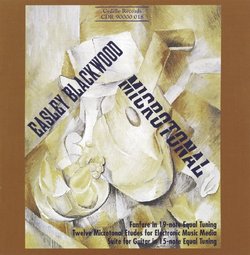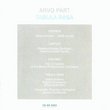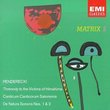A fascinating experiment in microtonal tunings
Ernest Barreto | Frederick, MD | 02/28/2000
(5 out of 5 stars)
"Easley Blackwood is a professor of music at the University of Chicago. From the liner notes: "In the late 1970's, Prof. Blackwood won a grant from the National Endowment for the Humanities to investigate the harmonic and modal properties of microtonal tunings. The project culminated in Blackwood's Twelve Microtonal Etudes for Electronic Music Media, composed as illustrations of the tonal possibilities of all the equal tunings from 13 to 24 notes to the octave." Though initially jarring to the ear (some tunings more so than others), one quickly adjusts to the new sounds. Once that happens, it's fascinating to hear Blackwoods exploration of "compelling progressions of hiterto alien harmonies and modes." Of course, some tunings work better than others. Also included is a piece for guitar in 15-note equal tuning. The sound of the guitar is much more appealing and effective than the "polyfusion synthesizer" used for the Etudes."
Great for the mind and the spirit
Ernest Barreto | 04/05/2002
(4 out of 5 stars)
"I am fascinated by this CD, plus I really enjoy it. The mathematical puzzles it poses are fascinating. I've found myself trying to design guitar and piano keyboards with some of the more interesting tone sets (15, 19) and wondering about different ways of writing music. I'd love to see Mr. Blackwood's notebooks on musical notations.
In addition, this is a lot of fun to listen to. Mr. Blackwoods compositions are sometimes a little basic, but I think he intended them that way in order to let the beauty and strangeness of these new modes just wash over us in their glory. He does a great job of tying the style of the composition to the tones that a given mode best expresses. Bravo!"


 Track Listings (17) - Disc #1
Track Listings (17) - Disc #1![Stockhausen: Stimmung [Hybrid SACD]](https://nationalbookswap.com/cd//m/30/9130/6159130.jpg)


